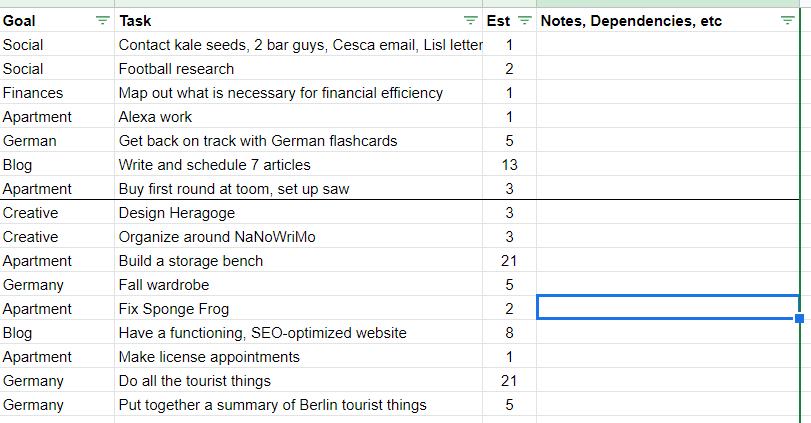This post contains an overview of exactly how I execute scrum in my personal life. If you’re looking for what I learned in the process of implementing this system in my life, head over to this post.
Situation:
I’m a to do list person. I justify this through a couple Katherine Catchphrases: “If I don’t write it down, I won’t remember it,” and “What isn’t tracked won’t improve.”
Complication:
My to do list is overwhelming. Because it contains everything, I end up spending more time figuring out what I should do rather than actually doing it. I’ve attempted to fix this in various ways in the past few years. Bullet journals, trying to evenly distribute tasks throughout a month, Eisenhower Matrix, Kanban boards, you name it, I’ve probably tried it.
I sought some balance between all the little things that need to be done and the big things that I want to have done.
Result:
Personal Scrum!
My Personal Scrum is how I keep track of, prioritize, and actually accomplish all the fun ideas that are bouncing around my head. And here’s how I did it.
Initial setup:
I listed EVERY SINGLE THING I could think to do in my life – big goals, small goals, lingering chores that don’t fall into my normal routines. EVERYTHING. As time goes on and I think of things to add, I just…add them to the bottom. This is called the backlog. I love my backlog in a way I’ve never loved another to do list. It’s a “someday” list instead of a “why haven’t you done this already?!” list!
My backlog lives in a Google Sheet. Here’s a quick shot of what’s in it:
Ongoing routine for Scrum in my Personal Life:
Every Sunday, I go through the list and roughly prioritize the whole list.
Mostly, I pull anything that MUST happen or that I’d really like to do in the next week to the top and move anything that I’ve lost interest in or that’s lost urgency further down. At this time, I also estimate how long it will take me to accomplish each task.
For time estimates, I use a Fibonacci sequence with the following estimated time values:
| Points | Time |
| 1 | 1 hour |
| 2 | 2 hours |
| 3 | Half day |
| 5 | Full day |
| 8 | Day and a half |
| 13 | Half week |
| 21 | Full week |
The benefit of using this process instead of guessing how many hours it will take is, well, I’m pretty terrible at estimating how much time things will take me. Like, horrifically bad.
Another benefit is that it accounts for transition time – it always takes time for me to get set up, gather materials, and get my brain into a task, so rounding up a bit (1 for an email, which should only take me 15 minutes to write…but then I have to find the person’s email, and what’s my German phone number again? And oops, my computer is dying, gotta get the charger…) allows me the right amount of buffer to do all the steps involved with a task, including setup and cleanup.
On Monday, I reflect on my previous sprint and set up for the next one*. Here’s how:
Clear off sprint page
First off, I copy-paste the list of tasks to my sprint archive tab, log how many points I accomplished, and remove all completed tasks from the backlog tab.
Selecting sprint tasks
Next, I only take as many points as I know I can accomplish in a week, based on a running average on my backlog tab. Starting at the top of my list, I sum up the estimate points, and when it hits my running average, I stop. I then put a line under the last item and consider if anything that I really want to do has fallen below the line. Then, I negotiate. I might take on a smaller chunk of a project (30 pages of a book instead of 100), or cut something entirely to make room for a task lower down. But the total point limit is non-negotiable.
Crafting a sprint goal
After that, I simply set an intention for the next week. It could be task-oriented (Get ready for guests – involving buying enough towels/sheets and cleaning the apartment) or just a way of summarizing the collection of little things I’d like to get done (Do the things you want to do – involving choosing time for reading, writing a newsletter for family, and logging Zack back into Netflix on his phone). The idea is to have a motivating philosophy for why you’re doing these specific things now and not in a later sprint.
Build action list
Once I have my tasks figured out, I boil down to the specific actions that I need to do. This is likely a Katherine Problem, but sometimes I get overwhelmed by a task before I even start! To combat that, I start my week by listing out every single action I need to take to complete the tasks. These are idiot-proof, stupid-level, tiny little things to do. For example:
Task: Hang art in dining room
Actions: Lay out gallery wall, Measure and hang first picture, Determine distance between pieces, Hang all pieces
See? Tiny actions, but by making them small, I’m more likely to make progress on the projects.
Finally, Monday through Sunday, I take action!
Every morning, I figure out which actions I’ll complete, and then go do them.
This is a work in progress, of course. One of the Scrum pillars is adaptation, which means every week, I’m choosing one way to improve my system and implementing it in the next week. I’ll probably revisit this post as my scrum shifts over time, but this is how I’m currently using scrum in my personal life!
If you want more information on using personal scrum in your life, check out these posts:
Personal Scrum Board: the BEST Organizational Tool
Creating Systems for Your Life
Why I’m Setting Intentions Instead of Goals for 2021
Timers for Productivity: When and How to Use Them
Bullet Journal Basics: 4 Simple Concepts




